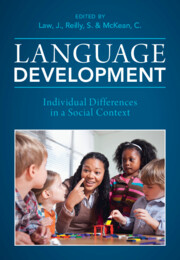Book contents
- Language Development
- Language Development
- Copyright page
- Contents
- Figures
- Tables
- Contributors
- A Tribute to Our Friend, Colleague and Fellow Editor, Professor James Law
- Introduction
- Part One Factors Influencing Language Development
- Part Two Continuity and Change
- 11 Language Trajectories in Childhood
- 12 Patterns of Language Development from Childhood to Adulthood and the Associated Long-term Psychosocial Outcomes
- 13 Social Inequalities in Vocabulary and the Role of Reading
- 14 The Dynamic Nature of Predictors and Outcomes in Children’s Language Development over Childhood
- Part Three Impact, Intervention and Equity
- Index
- References
13 - Social Inequalities in Vocabulary and the Role of Reading
from Part Two - Continuity and Change
Published online by Cambridge University Press: 11 August 2022
- Language Development
- Language Development
- Copyright page
- Contents
- Figures
- Tables
- Contributors
- A Tribute to Our Friend, Colleague and Fellow Editor, Professor James Law
- Introduction
- Part One Factors Influencing Language Development
- Part Two Continuity and Change
- 11 Language Trajectories in Childhood
- 12 Patterns of Language Development from Childhood to Adulthood and the Associated Long-term Psychosocial Outcomes
- 13 Social Inequalities in Vocabulary and the Role of Reading
- 14 The Dynamic Nature of Predictors and Outcomes in Children’s Language Development over Childhood
- Part Three Impact, Intervention and Equity
- Index
- References
Summary
Socio-economic differences in language have been noted as an important potential driver of ‘social reproduction’ – the transmission of socio-economic status from parents to children. Levels of language and vocabulary knowledge have also been implicated in wider social outcomes. This chapter provides a sociological perspective on language and vocabulary differences, and summarises some key empirical findings on a programme of work using UK birth cohort data. We address social inequalities in vocabulary, mechanisms of intergenerational transmission, and the role of reading for pleasure
Keywords
- Type
- Chapter
- Information
- Language DevelopmentIndividual Differences in a Social Context, pp. 302 - 321Publisher: Cambridge University PressPrint publication year: 2022
References
- 2
- Cited by

